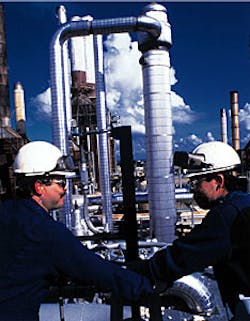New exchanger design keeps Puerto Rico BTX plant operating
Phillips nicknamed its two new vertical RODbaffle heat exchangers the "Texas Towers." The largest Texas Tower can be seen in this photograph (Fig. 1).Rather than spending $2.3 million to upgrade two trains of heat exchangers, Phillips Puerto Rico Core Inc. designed two RODbaffle heat exchangers for its aromatics facility in Guayama, Puerto Rico.
The two new vertical exchangers replaced 10 horizontal plate-baffle exchangers (Fig. 1 [28,224 bytes]).
According to Maria Scharre, a Phillips senior process engineer, the company saved more than $1 million in equipment costs. Additional savings can be found in energy consumption and equipment maintenance as a result of the reduced vibrations and pressure drops.
The RODbaffle heat exchanger differs from conventional plate-baffle designs. The RODbaffle uses rods, rather than plates, to support the tubes. Plate baffles induce cross-flow on the shellside of the exchanger, which increases the pressure drop and contributes to vibration. The RODbaffle design avoids vibration by using rods, which allow even movement of shellside fluids and lower pressure drops.
The aromatics facility processes primarily naphtha from Venezuela as well as some gasoline byproducts to produce aromatics, which include benzene, toluene, and xylenes (BTX).
The RODbaffle exchangers heat feed to the charge heater. The exchangers vaporize incoming feed on the tube side using heat from the reactor effluent on the shellside. Feed to the tallest RODbaffle feed/effluent exchanger enters at about 100° F. and leaves at about 600° F. The feed then flows through a process reactor before entering the second RODbaffle exchanger, which increases the stream temperature from 650° F. to 760° F.
Exchanger objective
In 1993, the Phillips aromatics plant was faced with rising feedstock costs and an inability to recycle paraffins to convert the last streams to benzene, toluene, and xylenes. Phillips engineers found a licensed technology, Chevron Chemical Co.'s Aromax reforming technology, to solve the problem (OGJ, Feb. 1, 1993, p. 24).The process added a new reactor between the existing exchanger trains. The existing exchanger configuration, however, had to be modified to accommodate the new reactor.
"The extra reactor produced a higher pressure drop than the plant's original design and created a challenge that the existing heat-exchanger trains couldn't handle," said Scharre.
To implement the new process, Phillips designed two large Phillips RODbaffle heat exchangers to replace the existing plate-baffle exchanger trains.
After 4 years of operation, the exchangers have an excellent performance record. They have a lower pressure drop than originally calculated and their feed rates are 110% of design.
Exchanger design
After studying the operation and economics of several heat exchanger designs, Phillips selected the RODbaffle heat exchanger design for the Puerto Rican plant."When we held both RODbaffle and plate-baffle exchanger designs to a 2.5 psi pressure drop, the RODbaffle design cost about $1 million less than an equivalent plate-baffle exchanger," Scharre said. "The plate-baffle exchanger might have been price-competitive at a 10 psi pressure drop, but at those levels we couldn't afford to keep the Puerto Rico Core facility operating."
The chosen design promised to provide superior pressure-drop performance and operation without tube-vibration failures. The exchangers' tube support rods create very little drag, thus absorbing very little energy, which minimizes the shellside pressure drop. Pressure drop in a RODbaffle exchanger can be up to 50% less than a typical plate-baffle exchanger.
The energy savings, moreover, reduced on-line operating costs. According to Mel Atkins, the Phillips senior engineering specialist who designed the heat exchanger system, "With the more stringent pressure-loss criteria, we could achieve higher heat transfer rates with the RODbaffle design. This resulted in less heat-transfer surface area needed and smaller, less costly, exchangers. The RODbaffle technology reduced total heat-transfer surface area by almost 40%."
The RODbaffle tube bundle design provides maximum tube vibration protection by using a four-point containment system. Within the span of four baffles, each tube is contacted by rods in four locations. The zero-clearance, convex-point contact between the rods and tubes, with alternating rod layout, completely locks each tube into a positive four-point tube containment system (Fig. 2 [41,942 bytes]).
Dimensions
According to Phillips, the larger RODbaffle exchanger is the world's tallest exchanger. Fabricated by Fabsco Inc., Sapulpa, Okla., it is 82 in. in diameter and 80 ft tall. The smaller RODbaffle exchanger, fabricated by Krueger Engineering and Manufacturing Co., Houston, is 72 in. in diameter and 22 ft tall.All shells and tubes are made of carbon steel. The larger exchanger has 157 rod-baffle rings to support 7,238 80-ft long, 0.625-in. OD tubes. The smaller exchanger uses 42 rod-baffle rings to support 4,615 22-ft long, 0.75-in. OD tubes.
All baffles are on 6-in. centers and fabricated of 0.1875-in. rods. The unusually large 82-in. diameter tubesheet and high liquid fraction on the tubeside feed inlet (0.714 wt % liquid) require an injection system to ensure uniform, two-phase flow distribution to all 7,238 tubes. The advanced spray injection system, designed by C.C. Gentry, Phillips corporate engineering branch manager, and R.W. Johnson, Fluor Daniel Williams Bros., Tulsa, has become the standard for larger RODbaffle heat exchangers with high liquid-inlet weight fractions.
The larger exchanger was so heavy (219 tons) that Fabsco used railcars to insert the tube bundle into the shell.
Copyright 1998 Oil & Gas Journal. All Rights Reserved.
